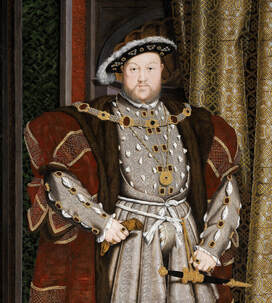
In 1513, 22 year old King Henry VIII waged a crusade in Europe on behalf of Pope Julius II, who had promised Henry recognition as a “most Christian King” if he would “utterly exterminate the King of France.” In 1521, Henry authored a book, “The Seven Sacraments” attacking Martin Luther and defending Catholicism’s view of the Sacraments. For this, the Pope gave Henry the title “Defender of The Faith.”
Henry was a Renaissance man, he was fluent in Latin, French and Spanish, an accomplished musician, theologian and Humanist scholar. Yet, despite Henry’s strong loyalties to the Pope, expressed in both blood and ink, Henry did much to open England to the Reformation. It was not so much that Henry embraced the Protestant faith, as much as he came to reject the authority of the Pope over English affairs. Henry was determined to have a male heir to the throne, to protect England from going through the kind of devastating civil war that his father had come to power through (The War of the Roses). Henry ended up going through 6 wives, 2 of whom lost their heads as a result of losing his favour. 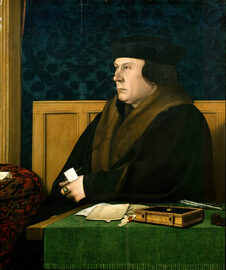
Chancellor Thomas Cromwell
Yet, England ended up officially Protestant, which was to a large extent thanks to Thomas Cromwell, Henry’s Chancellor. After exposing the corruptions and degeneracy of the monks and friars, Cromwell dissolved hundreds of monasteries between 1536 and 1539. Through this he also swelled the Crown’s treasury. Cromwell also succeeded in gaining Henry’s authorization for circulating copies of the Bible in English. Cromwell succeeded in transforming the nation’s Catholic clergy into leaders of a Reformed Church of England. This was done carefully, and with much court intrigue. Cromwell survived 11 years in the king’s service, but ultimately fell out favour with the king, and was executed on Tower Hill, 28 July 1540. 
King Edward VI
Upon the death of Henry VIII in January 1547, his 9 year old son, Edward VI ascended to the throne. Edward’s uncle, Edward Seymour, The Duke of Somerset became Lord Protector of the realm. The Duke of Somerset was, like Edward, a Protestant with strong Calvinist sympathies. He directed reforms, which dismantled all the restrictions that had been placed on the printing of Scriptures, and rapidly filled ecclesiastical positions with devout Protestants, such as John Hooper, Nicholas Ridley and Hugh Latimer. The “Book of Common Prayer” was authorised to reform worship and “The 42 Articles” to reform doctrine within the Church of England. England was not a Protestant nation at the close of the reign of Henry VIII. It was estimated that the majority of those living in London and the South Eastern part of England were Lutherans. But the West and North of England was still solidly Catholic. It was estimated that approximately three quarters of the total population were Catholic. However, during the brief reign of Edward VI tremendous progress was made in advancing the Reformation in England.
Within months of Edward becoming King, Parliament passed a law providing that communicants should be allowed to partake of the wine as well as the bread. In 1548, it was decreed that images should be removed from churches. In 1549, the celibacy of the clergy was done away with and marriage for priests and bishops was declared lawful. Also, in 1549, Parliament passed The Act of Uniformity making the use of The Book of Common Prayer compulsory in church services. The use of Latin in church services was abolished and substituted with English. By 1552, The Prayer Book had been revised, and a new creed had been formulated by Archbishop Cranmer, with the help of 6 other theologians, of which John Knox was one. The 42 Articles (which was later revised to The 39 Articles) laid a thoroughly Protestant and Evangelical doctrinal foundation for the Church of England. Most of the Catholic practices in worship had already been discarded. Prayers for the dead had ceased. The Communion table had taken the place of the altar. And in the Lord's Supper common bread was used instead of the wafer. The Church of England followed the Zwinglian practice of the bread and the wine being symbols of Christ's Body and Blood. But just as the Reformation in England seemed to be succeeding, its triumphant progress was halted and Catholicism regained most of the ground that it had lost since the reign of Henry VIII. In 1553, when he was only 16 years old, Edward VI died of Tuberculosis. Just before he died, Edward changed the Order of Succession, which his father, Henry VIII had laid out. To prevent his ferociously Catholic half-sister, Mary, undoing the Reformation work that he had set in motion, Edward named his cousin, Lady Jane Grey to succeed him as Queen of England. Unfortunately, Queen Jane's reign lasted only 9 days before she was overthrown and imprisoned in the Tower of London. 
Counter Reformation
Mary Tudor ascended the throne of England determined to undo all the work of the Reformation in England and to return the country to Catholicism. For a time, the Protestant Reformation had swept everything before it. Now, it seemed that the Reformation movement had been brought to a standstill. The peasants’ revolt in Germany, and the extremism and fanaticism of the Anabaptist revolutionaries, had, too many, discredited the movement. Divisions between the Lutherans in Germany and the Reformed Churches in Switzerland, also undermined the ongoing progress of the Reformation. These divisions were exploited by Charles V, who in 1546, the year that Luther died, launched a concerted attack against the Protestant princes of Germany. The Roman church had also been busy developing its own Counter Reformation. The Council of Trent had drawn up a list of forbidden books. This list, called The Index, was to protect Catholic readers from books that the Catholic church regarded as “false”, or “harmful”. Protestant writings were put on The Index and the spread of Protestant ideas was seriously curtailed, particularly in Southern and Eastern Europe.
The Inquisition, or “Holy Office” was granted more sweeping powers to detect and punish those who espoused Protestant doctrines. The Grand Inquisitor was accountable directly to the pope. The Inquisition effectively crushed the sparks of the Reformation in Spain and Italy. All those who were identified as having Protestant sympathies or involvement were jailed, killed or pursued into exile. In addition, the Catholic church now had The Society of Jesus or the Jesuits as they are better known. Founded by a Spanish soldier, Ignatius Loyola, and Francis Xavier, the Jesuits became the most dedicated soldiers of the pope to undermine the work of the Reformation and to win Protestant areas back to the Catholic church. The Jesuits succeeded in recovering most of Poland, Austria and Southern Germany for Rome. The Jesuits are credited with keeping Belgium and Ireland faithful to the pope. The Jesuits also performed extensive missionary work to extend Catholic control in the Americas. Protestants were burned at the stake as “heretics” in Spain, Italy, France, England and Scotland. Yet, the Dutch Protestant suffered even worse persecutions at the hands of the Catholic Inquisition. 
Tribulation in Holland
Under King Philip II of Spain, more than 18,000 Protestants were executed in the Netherlands. In an attempt to force them to confess to “heresy”, both men and women were mercilessly tortured. At that time, Spain was the most powerful country in the world. Holland was occupied by Spain. In 1566, Philip II issued a proclamation demanding that all his subjects accept the decrees made by the Council of Trent. Early in 1567, to crush the flourishing Protestant Faith in Holland, Philip sent in the Duke of Alva, who unleashed a reign a terror upon the Dutch Protestants. In 1568, the Inquisition condemned all 3 million inhabitants of the Netherlands to death as “heretics.” 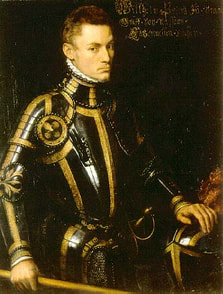
Protestant Resistance
Under the leadership of William, Prince of Orange, the Dutch Protestants rose up in resistance against Spain. William of Orange, and his courageous Dutch resistance fighters, became the inspiration of Protestants worldwide. The courage and tenacity of these Dutch Davids resisting the Spanish Goliaths attracted admiration and support, particularly from Protestant England. When the city of Leyden was besieged by Spanish troops, starvation and plague took a heavy toll. But the Protestants of Leyden refused to surrender. In July 1574 to chase out the Spanish occupiers, by flooding the land, William ordered the dykes broken. Although heavily outnumbered, the Dutch succeeded in outmanoeuvring the Spanish, especially at sea. By 1581, the united 7 Northern provinces of the Netherlands declared independence from Spain. The Dutch Protestant fight for freedom continued until 1648 when their independence from Spain was finally recognised. 
Fight For Survival
Until 1562, Protestants endured severe persecution and many martyrs were burned at the stake throughout Europe. From 1562 to 1648, Protestants throughout Europe had to fight for survival. Until the Peace of Westphalia in 1648, German, Danish and Swedish Lutherans and Dutch Calvinists had to fight for their lives against a relentless series of campaigns to crush them. In 1584, William, Prince of Orange, was murdered by an assassin’s bullet. Queen Elizabeth of England survived numerous attempts to assassinate her. Religious freedom was only achieved in England, Scotland, Holland and Germany by much sacrifice, vigilance, and by force of arms. 
Dr. Peter Hammond
See the book The Greatest Century of Reformation (288 pages, over 200 historic pictures and maps, 20 chapters and 16 appendices) from Christian Liberty Books, PO Box 358, Howard Place 7450, Cape Town, South Africa, Tel: 021-689-7478, Fax: 086-551-7490, Email: [email protected] and Website: www.christianlibertybooks.co.za.
1 Comment
Grahame Bennett
7/13/2022 11:59:24 am
Great history or the reformation of the church of Jesus Christ
Reply
Leave a Reply. |
History ArticlesCategories
All
Archives
May 2023
|
- Home
-
History Articles
- History Articles
- All Categories
- Character Studies
- Greatest Century of Missions
- Greatest Century of Reformation
- Reformation In Bohemia
- Reformation In England
- Reformation In France
- Reformation In Geneva
- Reformation In Germany
- Reformation In Italy
- Reformation In Scotland
- Reformation in Switzerland
- Victorious Christians
- Contemporary Articles
- Resources
- Contact
- Donate
|
The Reformation Society
PO Box 74, Newlands, 7725, South Africa Tel : (021) 689-4480 Email: [email protected] Copyright © 2022 ReformationSA.org. All rights reserved |
- Home
-
History Articles
- History Articles
- All Categories
- Character Studies
- Greatest Century of Missions
- Greatest Century of Reformation
- Reformation In Bohemia
- Reformation In England
- Reformation In France
- Reformation In Geneva
- Reformation In Germany
- Reformation In Italy
- Reformation In Scotland
- Reformation in Switzerland
- Victorious Christians
- Contemporary Articles
- Resources
- Contact
- Donate


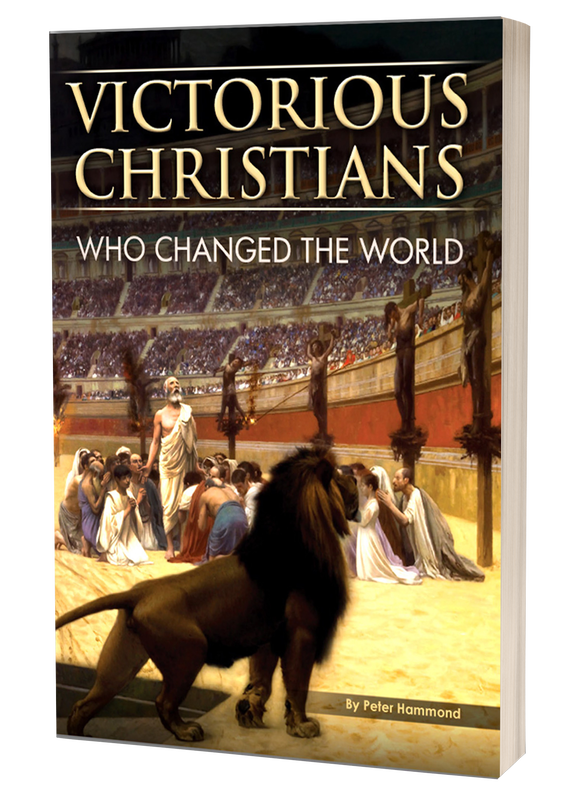
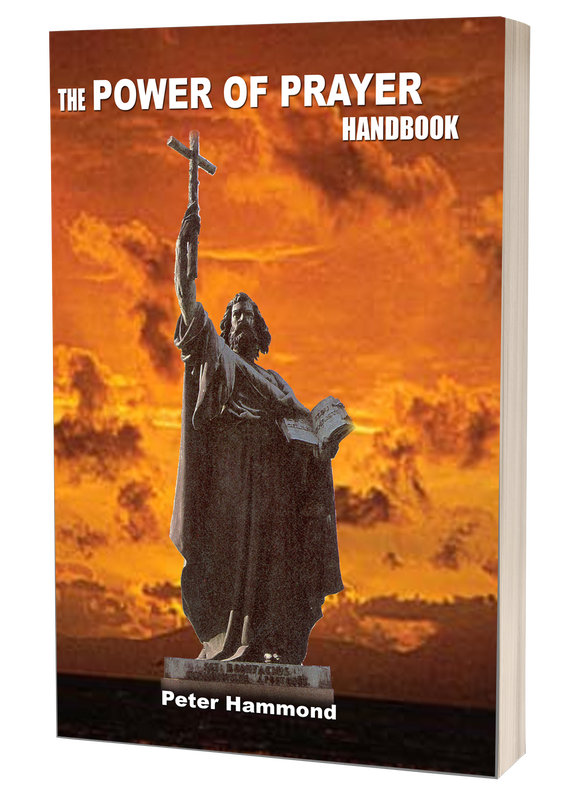
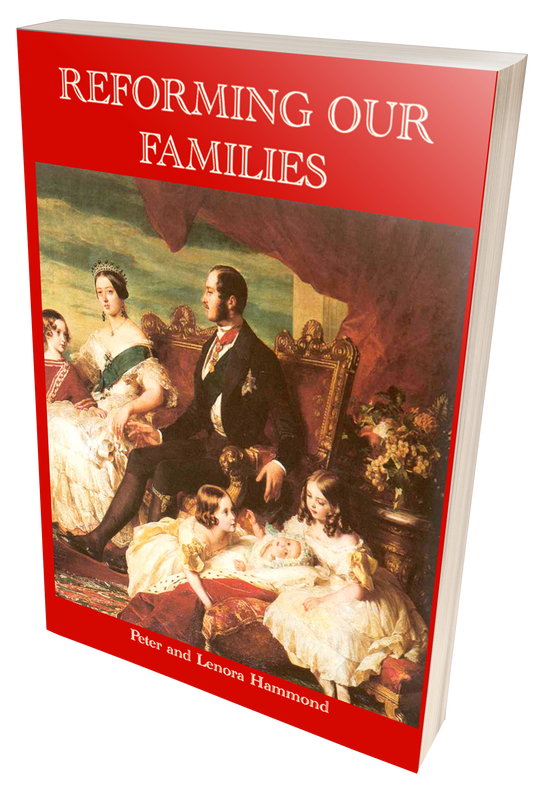
 RSS Feed
RSS Feed

